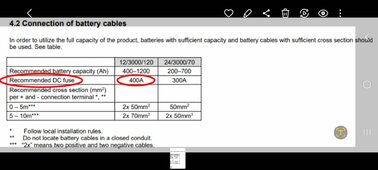robbob2112
Doing more research, mosty harmless
So, looked up the JK BMS and it appears they are using the HYG023N04LS1D mosfet -
data sheet https://xonstorage.blob.core.windows.net/pdf/huayi_hyg023n04ls1d_apr22_xonlink.pdf
Seems like the response time from on to off is 33ns ... even if they do a not great job of switching/monitoring that it is more than fast enough to protect the wire. (0.000000033 seconds)
Which comes down to the good quality verse cheap quality BMS... this would be in design, component, potting, and heatsink. If you figure it might be a way to save a few cents to leave out a few mosfet - they are strung in parallel to reach the current rating on the BMS with a few extra for safety margin. Now we can assume the cheaper end BMS will cut corners and the cheaper battery mfg will cut the same corners. The question is would those cut corners make a difference?
In the case of the LiTime batteries (the type the OP is using) and brand so far everything I have seen from them is done right and very good quality even when it would be possible to cut a corner and make things cheaper. So I would trust them for this at least that they wouldn't cut the corner enough to be dangerous.
So I am with Checkthisout and a fuse at the bus bar is good to protect the wires from the batteries and use the BMS as the fuse/protection at the other end.
So what about cheaper brands and low quality no-name BMS? Drop off a few mosfets and have just enough capacity to do the job with nothing to spare and run everything at max. Turn one down or off because of a surge in current? or overheat a few?
In my hazel past it seems like when fets are overcurrent or overtemp they tend to fail shorted - sometimes with an exploding sort of result if the PSU behind it melts the junction and then the silicone fractures the case.
Do we as a collective group have a history of how BMS tend to fail when there is enough of it left to look at?
data sheet https://xonstorage.blob.core.windows.net/pdf/huayi_hyg023n04ls1d_apr22_xonlink.pdf
Seems like the response time from on to off is 33ns ... even if they do a not great job of switching/monitoring that it is more than fast enough to protect the wire. (0.000000033 seconds)
Which comes down to the good quality verse cheap quality BMS... this would be in design, component, potting, and heatsink. If you figure it might be a way to save a few cents to leave out a few mosfet - they are strung in parallel to reach the current rating on the BMS with a few extra for safety margin. Now we can assume the cheaper end BMS will cut corners and the cheaper battery mfg will cut the same corners. The question is would those cut corners make a difference?
In the case of the LiTime batteries (the type the OP is using) and brand so far everything I have seen from them is done right and very good quality even when it would be possible to cut a corner and make things cheaper. So I would trust them for this at least that they wouldn't cut the corner enough to be dangerous.
So I am with Checkthisout and a fuse at the bus bar is good to protect the wires from the batteries and use the BMS as the fuse/protection at the other end.
So what about cheaper brands and low quality no-name BMS? Drop off a few mosfets and have just enough capacity to do the job with nothing to spare and run everything at max. Turn one down or off because of a surge in current? or overheat a few?
In my hazel past it seems like when fets are overcurrent or overtemp they tend to fail shorted - sometimes with an exploding sort of result if the PSU behind it melts the junction and then the silicone fractures the case.
Do we as a collective group have a history of how BMS tend to fail when there is enough of it left to look at?




